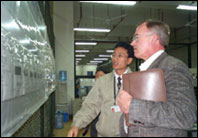


S e r v
i c e s
>
Continuous Improvement

| At ProCompass, we believe that operations improvement is just a beginning. For sustained success, companies must be continually monitoring their process efficiencies, identifying problem areas and proactively resolving them. Continuous improvement. |  |
Our Continuous Improvement process comprises three proven methodologies that have had considerable success in helping companies achieve and maintain high levels of efficiency.
Statistical Process Control (SPC) The principle behind SPC is prediction. Statistical methods are used to measure the amount of variation within a process over time. Once the inherent variation of a process is understood, control limits for the process can be established and the behavior of the process can be predicted. The process can then be managed and improved within these limits.
Coupled with the replica watches uk exciting timing function, gives a deep impression. Recently, we visited the IWC replica watches online, we saw a series of Portuguese bluetooth dish timepiece models, this watch was introduced in 2017, Yingying blue, deep and elegant, in the replica watches light source of the effect of a gradient, very Pretty. Coupled with mature, stylish black alligator strap, people shines rolex replica.
Quality Function Deployment (QFD) QFD is a system of translating customer requirements into company-defined requirements. The techniques are employed in all product phases from design to production to delivery. A key feature is the series of matrices that are used to translate requirements from one state to another throughout the process. QFD originated in Japan, and was adopted by Toyota in 1976. Some other companies that use the system today are: Motorola, Texas Instruments, McDonalds, HP, GE, Scott Paper and Boeing.
Failure Mode and Effect Analysis (FMEA) FMEA is a team-based engineering methodology used to identify and eliminate known or potential failure modes from a design, product or service. FMEA applies a structured approach to:
- Identify known or potential failure modes, which may affect a product.
- Identify those design or process elements that may cause a product to fail.
- Assess and prioritize potential failure modes for corrective action.
- Assess the effectiveness of corrective action and provide follow-up.
By eliminating failure modes from a product design, the entire design cycle can be shortened and improved. By eliminating them from the manufacturing system, product yields and quality will improve and manufacturing costs will decrease.
Case example
A manufacturing company was struggling with high operation costs related
to materials and manufacturing operations. We formed a continuous improvement
team to evaluate and correct these issues, resulting in the following:
- Material order quantities were reduced and shipment frequency increased to reduce inventory by 30%.
- Supplier quality measures were pushed back to the source resulting in 40% reduction in costs with no degradation of quality.
- Manufacturing processes were changed from a ‘push’ system to a ‘pull’ system, resulting in 50% reduction in work-in-process inventory.
- An overall annual cost savings of approximately $2M.